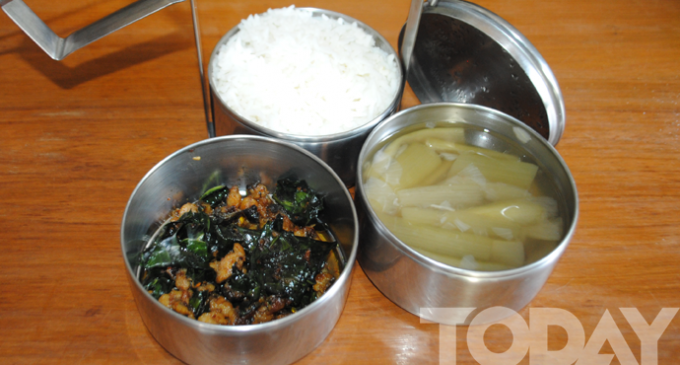The tiffin carrier – how long will it survive?

It’s twelve noon and it’s the usual time for most Myanmar people to “eat rice”. In Grade IV, Section A, eight year old Aung Zaw Myint takes out his steel three-tired tiffin carrier from his plastic basket and places each tier on his desk. His friend Ko Ko Maung, like many other students, does the same. Aung Zaw Myint looks at each tier of the tiffin carrier. As expected, the first contains rice. The second contains fried chicken. The third contains stir-fried vegetables. He doesn’t care very much for vegetables. He would have the rice and the chicken first and finish the vegetables later. He must finish it, or May May will scold him. He peeps at the three tiers of his friend Ko Ko Maung’s tiffin carrier. One contains huge chunks of three layered pork. He looks enviously at the pork curry. May May rarely cooks pork. She says it makes Phay Phay ill after he eats it. “Want to swap a piece of my chicken with a piece of your pork?” he asks Ko Ko Maung. His friend nods. Aung Zaw Myint puts a piece of fried chicken into his friend’s tiffin carrier and in return Ko Ko Maung reluctantly gives him a piece of pork. Like Aung Zaw Myint, pork is his favourite dish.
It’s lunch break at the university. Some of the students go to the canteen to have lunch but Nang Thida and her four friends usually bring lunch from home. Lunch break is their favourite time. They can trade news, gossips and most importantly, food. Everyone is eager to find out what Nang Thida has brought because her mother comes from Shan State and is also an excellent cook. Her food is always tasty and a bit different from others. Today, it is May Thanda who gets hold of Nang Thida’s tiffin carrier. “What’s that?” she asks, pointing at the content of one of the tiers. “It looks like some kind of salad,” Sanda Thein chipped in. “Yes, it’s a salad. It consists of grated stem and root of the Awe-zun plant found in Shan State, cellophane noodle, sliced onions, crushed roasted peanuts, dried shrimp powder, fried crispy garlic and a dash of lemon. Try it. It’s my favourite salad,” Nang Thida explained. After the shared meal, the group troops to the canteen to have their favourite iced strawberry drink.
After a hectic morning dealing with demanding clients, Ma Mee, Seint Seint, Ko Kyaw Thu and Ko Myat Min gathered around Ma Mee’s desk to have their lunch. Today, except for Ko Kyaw Thu, the other three have brought their tiffin carriers. “My youngest kid isn’t well, so my wife couldn’t cook anything for my lunch,” he said. “Never mind. You can share ours,” they said in unison. They are used to Ko Kyaw Thu not bringing his lunch. He has three kids and they understand his problems. Ma Mee takes out a plate, a spoon and a fork from the drawer of her desk, wipes them clean with a napkin and everyone starts putting onto the plate a bit of whatever they have brought in their tiffin carrier and soon it’s full.
It’s time to take a break for lunch at the construction site. The group of masons sits under a shady tree. Sitting among them is their leader, U Pein. The men open their three-tiered tiffin carriers. The top tiered contained the curry, while the bottom two contained the rice. They put in a little bit of whatever curry they brought into U Pein’s tiffin carrier. He doesn’t really want them to do so, but he doesn’t want to break the Myanmar tradition of offering first a bit of food to one’s elders and seniors and so he accepts the food reluctantly. He knows that the food will be the same as on other days – things that they can afford like fried egg, duck egg curry, curried tiny fish, fried pebyoke (boiled peas), fried bean sprouts and tofu, fried seasonal vegetables, or tea leave salad. Most of the masons are daily wage earners and lead a tough life. After the uneventful meal, some of the masons would chew a quid of betel and return to their work.
Like in cities and towns all over the world, food stalls and restaurants of all sizes and prices have sprung up around offices and crowded places in Myanmar urban areas. However, millions of Myanmar students and workers still bring their lunch from home in three tiered steel tiffin carriers. Wives and mothers, and in some cases, fathers, get up early in the morning to go to market and buy things to cook. They return home, peel the onions and pound them with chillies for the curry paste. Then, they chop, fry, boil, or stew whatever ingredients have been chosen to cook the dishes of the day. A few lucky ones have maids to shop, cook, clean and wash for them. But for those who are involved in preparing food to be taken in tiffin carriers, they have to not only master the art or science of budget management to make the money last till the end of the month, but they also have to learn to manage time to make sure that the tiffin carriers for those family members going to work or school are ready in time. For the Myanmar people, steel may be a modern product but the tiffin carrier is not a new invention. Since time immemorial, lacquer tiffin carriers have been in use to take food to monasteries to offer to monks on Sabbath days, or to send food to one’s relatives and friends, and so also is the custom of sharing one’s food with friends and colleagues.
As more and more Myanmar women work, there seems to be less time for them to carry out mundane activities like shopping for food and cooking. So the question is, “Will we be able to continue taking the food prepared by our beloved ones to school and work, or will this practice disappear like in some of our neighbouring countries and be replaced by fast-food meals with unknown ingredients prepared by unfamiliar persons, and served by expressionless waiters in nondescript fast-food stalls and restaurants after queuing up with strangers?”
by Myo Myint
./wp-content/uploads/2018/10/Emirate-Online-TDY.png)

















There are no comments at the moment, do you want to add one?
Write a comment